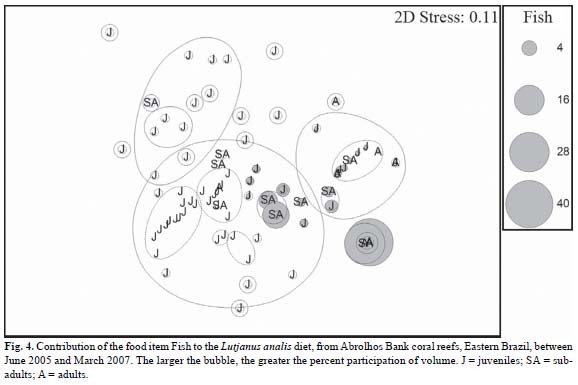Diet and feeding ecology of the mutton snapper Lutjanus analis were investigated in the Abrolhos Bank, Eastern Brazil, the largest and richest coral reefs in the South Atlantic, where about 270 species of reef and shore fishes occur. To evaluate seasonal and ontogenetic shifts in the diet, specimens of L. analis were obtained through a fish monitoring program in four cities in southern Bahia State, from June 2005 to March 2007. Stomachs from 85 mutton snappers that ranged in size from 18.1 to 74.0 cm TL were examined. Prey were identified to the lowest possible taxon and assessed by the frequency of occurrence and volumetric methods. Variations in volume prey consumption were evaluated using non-metric multi-dimensional scaling ordination, analysis of similarity, and similarity percentage methods. Significant differences in diet composition among size classes were registered, whereas non significant differences between seasons were observed. Considering size-classes, food items consumption showed important variations: juveniles (<34.0 cm TL) fed mostly on crustaceans, sub-adults (34.1-50.0 cm TL) showed a diversified diet and adults (>50.1 cm TL) consumed basically fish, mostly Anguiliformes. Lutjanus analis is an important generalist reef predator, with a broad array of food resources and ontogenetic changes in the diet. This snapper species plays an important role on the trophic ecology of the Abrolhos Bank coral reefs.
Diet; Mutton snapper; Ontogenic variations; Seasonal






